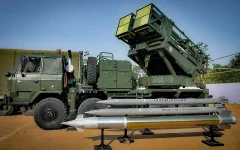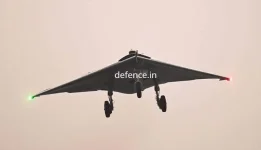- Views: 2K
- Replies: 9
India's indigenous artillery firepower is set for a major enhancement as the Defence Research and Development Organisation (DRDO) has laid out an ambitious timeline for developing and inducting next-generation Pinaka rocket systems.
Dr. Samir V. Kamat, the DRDO Chairman, announced that the Pinaka Mk3, with a 120 km range, will be ready for army induction within three years, while the formidable 300 km range Pinaka Mk4 is planned for induction within five years.
This accelerated plan is a significant step forward in the nation's "Aatmanirbhar Bharat" (Self-Reliant India) initiative in the defence sector.
The Pinaka multi-barrel rocket launcher (MBRL) system has become a crucial element of the Indian Army's battlefield strategy.
Developed by DRDO's Armament Research and Development Establishment (ARDE) and produced with Indian industrial partners, the system is named after the mythical bow of the Hindu deity Shiva.
It is designed to launch a swift and devastating attack on enemy assets such as troop formations, command centres, and armoured vehicles.
The Indian Army already operates the earlier Pinaka Mk1 (40 km range) and the upgraded Pinaka Mk2 (75 km range), which have been successfully deployed to bolster India's border defences.
According to Dr. Kamat's announcement, the upcoming Pinaka versions are being engineered to serve as a versatile, long-range precision strike weapon.
The Pinaka Mk3 and Mk4 are intended to fill a critical operational gap between the army's conventional tube artillery and its more strategic tactical ballistic missiles, providing a powerful and cost-effective solution for modern combat scenarios.
Pinaka Mk3: Doubling the Reach with High Precision
The Pinaka Mk3 variant will nearly double the range of its predecessors, capable of striking targets up to 120 km away. This significant increase is achieved through advanced rocket motors, lighter airframes, and sophisticated guidance technology.The system will employ precision-guided rockets equipped with GPS and an inertial navigation system, allowing it to hit targets with an accuracy measured by a Circular Error Probable (CEP) of less than 10 meters.
Maintaining the system's core strength, a single Mk3 launcher will be capable of firing a full salvo of 12 rockets in just 44 seconds. An army regiment equipped with 18 such launchers can saturate a target area of one square kilometre.
The launchers are also being upgraded with enhanced automation and will be able to fire a variety of warheads, including high-explosive and anti-tank munitions.
Currently in its final development phase, the Pinaka Mk3 is expected to begin army trials by late 2025, with production partners Bharat Dynamics Limited (BDL) and Larsen & Toubro (L&T) preparing to meet the 2028 induction goal.
Pinaka Mk4: A Quasi-Ballistic Leap in Firepower
Representing a monumental leap in rocket artillery, the Pinaka Mk4 is being developed with a range of 300 km, placing it in the category of a quasi-ballistic missile.This variant will provide the Indian Army with a deep-strike capability comparable to advanced international systems, enabling it to target high-value enemy assets like airfields, radar sites, and missile batteries far behind the front lines.
Its extended reach is made possible by a larger rocket design and advanced solid-fuel propulsion.
The Mk4 will feature state-of-the-art technology, including a dual-mode guidance system that uses an active radar seeker for terminal accuracy. This will enable the system to engage even moving targets with a CEP of under 5 meters.
Furthermore, its propulsion system can be throttled, allowing for trajectory adjustments to enhance accuracy and evade enemy air defence systems.
Dr. Kamat noted that the Mk4 is being designed as a modular platform capable of launching diverse payloads, including next-generation smart and loitering munitions.
Development of the Pinaka Mk4 is underway, with prototype tests scheduled for the 2027-2028 period. The system is a key part of the Indian Army’s Artillery Modernization Plan, which aims to operate 22 Pinaka regiments by 2030, with induction of the Mk4 slated to begin by that year.





